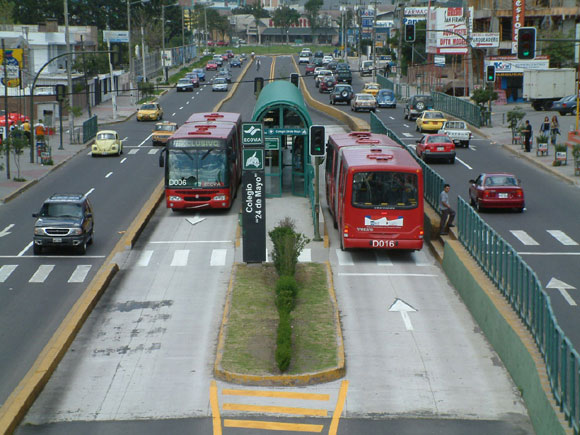John Petro
Learning to Love Bus Rapid Transit (Maybe)

BRT in Quito, Ecuador. Buses have a physically separated lane and boarding stations.
Yesterday, Streetsblog posted an interview with Walter Hook, who is the director of the Institute for Transportation and Development Policy and considered to be an expert on Bus Rapid Transit (BRT). Mr. Hook talked of the benefits of adopting BRT in New York City as an alternative to fixed rail.
The optimists are telling us that we will have a Second Avenue Subway between 125th street and 63rd Street by 2015 and only after we spend $4 to $5 billion. So this means we are probably talking about 2018 or 2020, and $10 billion. The Second Avenue Subway would be great, it’s needed, it would have higher demand than almost any other metro line in the country. At those volumes, metros are often a good investment. But will it happen?Plus, the MTA needs something like an additional $20 billion just to bring the existing system into a state of good repair. If we only talk rail, that puts any mass transit improvements to my neighborhood -- Brooklyn adjacent to the hole in the ground that may one day be Atlantic Yards -- off the radar for two decades, even though they are talking about introducing Manhattan-level densities into my neighborhood in the next few years.
BRT, Hook says, is a good alternative because of the cost. He says BRT lines have been completed for as little as $8 million a mile. Light rail, according to Mr. Hook, does not have any advantages over BRT in a city like New York, because the cost of light rail is so much higher than BRT while the speed and capacity of both systems is nearly the same.
The issue of BRT service is especially pertinent at this time because expanded and enhanced bus service is a major part of the Ravitch plan. In fact, the revenue from East River bridge tolls would go specifically to bus service under the plan. Expanding bus service is necessary, according to the Ravitch plan, in order to provide alternatives for those that are diverted from driving because of the tolls.
The Commission believes that the MTA should increase its investment in BRT, a strategy that has the potential to make significant breakthroughs in improving bus performance.
I have to admit that, at first, I was very skeptical of BRT. This is because I didn’t believe that planners and public officials would take the steps necessary to make BRT a success. True BRT requires significant investment: in the buses themselves, in boarding platforms, and in the roadway infrastructure. BRT also requires the political will to take road space away from passenger cars and parking as well as the enforcement of bus-only lanes – something that is a very heavy lift, politically speaking.
But this argument against BRT is unfair. It’s the same type of argument I’ve railed (no pun intended) against in relation to those who have proposed abandoning the Second Avenue Subway. The argument is basically that it is too hard to achieve. But when a certain investment is needed, this argument doesn’t hold up, it becomes a matter of apathy and laziness.
BRT, if done correctly, is something that we should support. However, it should not be used as a substitute in situations where heavy rail is needed. It is also not a substitute for light rail systems that have their own right-of-way (unless the BRT line also has its own right-of-way, in which case the cost comparisons become more even). Also, light rail may be more appropriate when a city or region is trying to change land use patterns, such as the case in Charlotte, NC, since developers may be more likely to invest in an area with fixed rail than BRT.
New York City already has had some success in enhancing bus service on the Bx12 line in the Bronx. The improvements have reduced travel times on the route and cost about $10 million. New York City has plans for six other lines in which bus service will be enhance to varying degrees.
So, if we're going to implement BRT, let's make sure that we do it correctly. A BRT line should have its own lane, physically separated from traffic with a curb. Buses should be given priority at intersections. It should have boarding stations with turnstiles where passengers pay their fare before boarding. Stations should be raised so that they are even with the bus floors.
Anything less and transit riders are being shortchanged.
John Petro: Author Bio | Other Posts
Posted at 7:38 PM, Feb 24, 2009 in
Transporation | Urban Affairs
Permalink | Email to Friend










